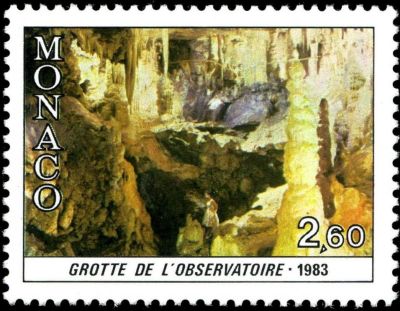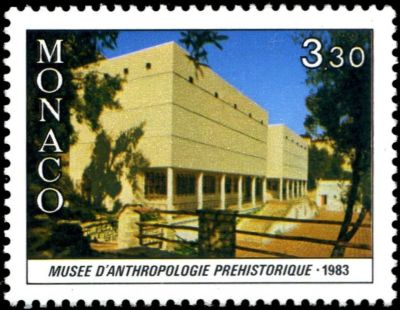Monaco 2025 "Europa 2025 - National Archaeological Discoveries"
| << previous page | back to index | next page >> |
| Issue Date | 09.05.2025 |
| ID | Michel: 374; Scott: Stanley Gibbons: ; Yvert et Tellier: ; Category: pF |
| Designer | Andre Lavergne |
| Stamps in set | 1 |
| Value | 2,10€ - the Observatory Cave and various artefacts |
| Emission/Type | commemorative |
| Issue place | Monaco |
| Size (width x height) | 40.0 mm x 30.0 mm |
| Layout | Mini Sheets of 10 stamps |
| Products | FDC x1 MS x1 |
| Paper | 3 colors steel-engraving |
| Perforation | 13 x 13.25 |
| Print Technique | 6 colours steel-engraving |
| Printed by | |
| Quantity | 40.000 |
| Issuing Authority | Office des Emissions de Timbres-poste, Principauté de Monaco |

On May 9th, 2025, the Post of Monaco issued the stamp "EUROPA 2025 - National Archaeological Discoveries".
This stamp features the Observatory Cave (Grotte de l’Observatoire) in Monaco, one of the earliest known human occupation sites in the region, dating back approximately 250,000 years, and five objects from the collection of the Museum of Prehistoric Anthropology of Monaco, founded in 1902 by Prince Albert I.
A Paleolithic biface (hand axe) and the skull of a modern, rather than prehistoric species of lynx were discovered in the cave. The other objects: an amphora, a gold coin, and a bracelet were discovered elsewhere in the Principality of Monaco.
The Observatory Cave
The cave is located at the base of the cliff within the Exotic Garden of Monaco (Jardin Exotique de Monaco). It extends 103 meters deep and has been open to visitors since 1946. Its entrance lies roughly 100 meters above sea level. The site is named after a small astronomical observatory that once stood nearby.The Observatory Cave is considered one of the key Paleolithic reference sites in the western Mediterranean, offering one of the longest continuous occupation sequences in southern Europe.
Initial excavations were carried out by the French Catholic priest (Canon) and prehistorian Leonce de Villeneuve between 1916 and 1920.
Leonce de Villeneuve (1858–1946) was a French Catholic canon and early prehistorian who played
a key role in Monaco’s archaeological history.
Between 1916 and 1920, he carried out the first systematic excavations of the Observatory Cave.
Working during and after World War I, Villeneuve uncovered stratified layers of prehistoric occupation
spanning several hundred thousand years.
His discoveries included Paleolithic stone tools, animal remains, and traces of both
Homo erectus and Neanderthal activity.
The results of his work were later published in 1927 in collaboration with renowned paleontologist
Marcellin Boule, in the monograph
La grotte de l’Observatoire à Monaco.
Villeneuve’s excavations laid the foundation for all subsequent research at the site and helped
establish the Museum of Prehistoric Anthropology of Monaco as a major institution for the study of
early human history in the western Mediterranean.
Their results were published in various bulletins of the Musée d’Anthropologie Préhistorique de Monaco and referenced in later syntheses of Monaco’s prehistory.
The combination of human-made tools and faunal remains provides valuable insight the coexistence of prehistoric humans and large carnivores in the region. Although the site was first excavated over a century ago, archaeological work continues in certain areas of the cave today, supplemented by ongoing laboratory research.
Today, the cave is part of a guided tour that leads visitors through geological formations and prehistoric excavation zones, making it both a scientific site and an educational attraction.
 |
 |
 |
|
The grotto in the Observatory Cave and the Museum of Prehistoric Anthropology of Monaco
on stamps 50 years of exotic garden, Sightseeing of Monaco
of Monaco 1983, MiNr.: 1574, 1575; Scott: 1364, 1365.
|
Prince Albert I, entrance of the Observatory Cave and the same hand axe on Centenary of excavations at Exotic Garden Cave stamp of Monaco 2016, MiNr.: 3303, Scott: . | |
Products and associated philatelic items
| FDC | First-Day-of-Issue Postmark | Mini-Sheet |
 |
 |
 |

|
References
- Technical details and short description of the stamps: website of Post of Monaco, Government of Monaco, Living in Monaco, Monaco Tribune, La Gazette de Monaco.
- Observation Cave: official website, Government site of Principality of Monaco.
Acknowledgements
Many thanks to Dr. Peter Voice from Department of Geological and Environmental Sciences, Western Michigan University, for reviewing the draft page and his valuable comments.| << previous page | back to index | next page >> |